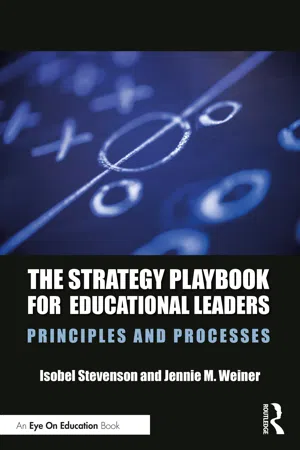
The Strategy Playbook for Educational Leaders
Principles and Processes
- 128 pages
- English
- ePUB (mobile friendly)
- Available on iOS & Android
The Strategy Playbook for Educational Leaders
Principles and Processes
About This Book
This how-to resource provides leaders with a concrete framework for a strategic improvement plan, helping educators link the "principles" to "processes" of planning. Packed with key takeaways and additional resources, this book provides the concrete tools to design a strong strategy for improvement and enables educational leaders to think constructively about why we plan, what an effective strategic plan should contain, and how to create meaningful dialogue to support plan development, implementation, and monitoring for continuous improvement.
The Strategy Playbook for Educational Leaders provides superintendents, central office staff, principals, and teacher leaders with the opportunity to reframe the process of their strategic planning and breathe new life into the activity.
Frequently asked questions
Information
Part
1
Setting the Stage
1
Strategic Planning for Continuous Improvement
- Equity
- Logic
- Capacity
- Coherence
Introducing Superintendent Jenkins
Superintendent Maria Jenkins sat down at her desk to start thinking about the design of a strategic plan for her district, Ashburn. She was in her first year as superintendent and wanted to get this right. While she knew this process would be time consuming and sometimes challenging, Maria was also aware that she was well positioned to engage in this work. Her board and community were behind her, the school administrators were a strong team, and she was pleased at the way things were going in Ashburn since her arrival.From her experience in her previous district, Maria knew any changes she wanted to make would be much easier if she could justify them by saying she was responding to community and/or staff requests and/or concerns. She was therefore happy to spend her first few months listening and learning, as she was confident people who lived and worked in the district would have a great deal of insight into what was working and what should be improved. She also knew it was really important for the board to feel they were fully informed, consulted, and involved in her thinking, so when the chair of the board suggested it would be a good time for them to revisit the district’s strategic plan, she was glad to do so.Enrolling approximately 20,000 students and comprising nine elementary, four middle, and three high schools, Ashburn is a growing community. One of the state’s poorest cities, Ashburn serves a diverse group of families across several demographic variables. This diversity is reflected in Ashburn’s schools. While access and outcomes among different groups of students (Black, Latinx, English language learners, special education, etc.) remain an issue, differences in assessed areas are smaller than state averages. At the same time, there remains variability across schools in terms of their overall performance, school culture, and relationships with family and community.Maria was responsible for creating strategic plans in the past, first as a principal and then as an associate superintendent in her prior district, and she found these plans less than helpful. Her experience with district and school improvement planning was that it was more about templates, “wordsmithing,” and compliance, and did little to shape the daily work of administrators and teachers.Maria knew she had to think about several things to start with, and there could be other considerations related to the planning process that hadn’t occurred to her yet. She started making a list:
Why This Book?
Table of contents
- Cover
- Half Title
- Series Page
- Title Page
- Copyright Page
- Dedication
- Table of Contents
- Preface
- Acknowledgments
- eResources
- Part 1 Setting the Stage
- Part 2 Getting to Business
- Part 3 Monitoring and Continuous Improvement